
Michael von Graffenried. "Riot Police," 2007. Photographic c-print on dibond, 112.5 x 49 inches. © Michael von Graffenried, courtesy Parker's Box Gallery, Brooklyn.
At times Western art functions as a lagging indicator of historic events. At their best, such works—from Picasso’s Guernica to Art Spiegelman’s In the Shadow of No Towers—become touchstones for how we belatedly understand, process and respond to seismic social and political events. Michael von Graffenried’s photographic series Inside Cairo, currently on view at Parker’s Box Gallery in Brooklyn, tantalizingly offers the prospect of revealing what the Egyptian capital was like before the unprecedented demonstrations that culminated in Tahrir Square transformed a nation and captivated a global audience.
The result of a three-month residency project in Cairo in 2007, von Graffenried’s Inside Cairo series focuses on the quotidian activities and daily rituals of everyday life in Egypt’s capital city: children leaving school, a garbage collector, men gathered for Friday prayers and the bustle of the Birqash camel market on the city’s outskirts. His large-scale panoramic prints are claustrophobic compositions filled with rich characters.
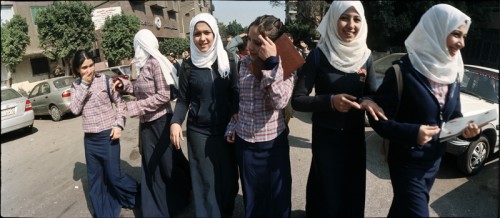
Michael von Graffenried. "School's out for Girls," 2007. Photographic c-print on dibond, 112.5 x 49 inches. © Michael von Graffenried, courtesy Parker's Box Gallery, Brooklyn.
As a European photographer (born in Switzerland in 1957 and currently based in Paris) roaming the decidedly less touristic neighborhoods of Cairo, von Graffenried’s noticeable presence in these poor, out-of-the-way areas would invariably draw the attention and perhaps suspicion of his photographic subjects, thereby spoiling his ability to capture candid scenes. To overcome this, von Graffenried used a small panoramic Widelux camera with a swing lens, a feature that allowed him to take photographs while holding the camera at his side or chest, and without conspicuously pointing his camera at his subjects. This surreptitious technique calls to mind Walker Evans’ famous subway portraits and Paul Strand’s side-mounted lens, and like his photographic predecessors, it allowed von Graffenried to minimize the impact of his presence and to take pictures of unsuspecting people going about their daily business in unguarded moments.
Von Graffenried’s everyday subject matter and the candidness of his shots certainly reinforce the proposition that we are probing deeply into the authentic fabric of Cairene life. His images carry the authority of documentary photographs and have a photojournalistic feel, so much so that some local Egyptian gallerists balked at exhibiting Inside Cairo for fear that the photographs, if viewed as press material, would be subjected to official censorship. Even the title of the series, Inside Cairo, suggests that these images provide some penetrating insight, some truthful look into the city’s people and pulse. Fittingly, curator Harald Szeemann concluded that the immediacy and spontaneity of von Graffenried‘s process allows viewers to be “at the heart of the event [depicted].”[1]
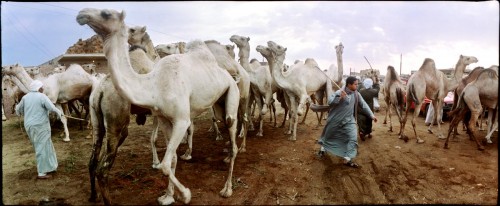
Michael von Graffenried. "Birquash Camel Market, Cairo," 2007. Photographic c-print on dibond, 30 x 13 1/2 inches. © Michael von Graffenried, courtesy Parker's Box Gallery, Brooklyn.
The more I looked at these monumental photographs, however, the more they seemed to resist my desire for insight into pre-revolutionary Cairo, resist providing for some sort of revelatory Truth with a capital T. I couldn’t put my finger on the nature of this resistance until I happened upon a particular anecdote, in which von Graffenried, while recounting the reluctance he faced from locals while trying to get his photographs printed, related the following: “I first had a picture of the Birqash camel market printed on canvas sheet. When I came back with the other pictures, the woman in the shop asked me what the subject matter was. This is Cairo, I said, don’t you recognize your city?”[2]
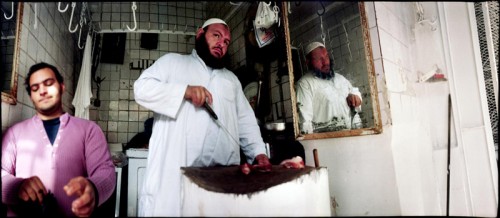
Michael von Graffenried. "Butcher," 2007, photographic c-print on dibond, 112.5 x 49 inches. © Michael von Graffenried, courtesy Parker's Box Gallery, Brooklyn.
That this woman didn’t recognize “her” Cairo in von Graffenried’s impressive photographs startled me and, returning to the idea encapsulated by Szeemann’s sentiment, prompted me to reconsider what, exactly, are we as viewers penetrating to the heart of in these images, if not this shopkeeper’s Cairo? Von Graffenried provides one possible answer to this question in his response to another local resident who, when confronted by the artist’s stunning photograph of a local butcher plying his trade, asked the photographer why he would want to take a picture of a terrorist. “The picture,” von Graffenried mused, “says more about the person looking at it than the photographer.”[3]
Indeed.
In this vein I, and I suspect others, cannot help but search in von Graffenried’s Cairo for the Cairo I know, which in reality is little more than the Cairo of Tahrir Square, the Cairo that dramatically unfolded in real time on television, captivating the world and keeping me utterly riveted to CNN for days on end. I suppose I could not help but search for signs in von Graffenried’s photographs of the restlessness and simmering discontent that (to my mind) led to that revolutionary moment. Might von Graffenried somehow presciently bear witness to the undercurrents that would in a few years crescendo into the groundswell of social protest that changed the arc of history for a country, a region and perhaps the world? I looked intently at his images of robust urban landscapes and the mosaic of faces populating them for clues, but the photographs stubbornly yielded no clear answers.
Of course, the compelling image of a phalanx of riot police is suggestive, and in truth my gaze returned to it again and again. Aside from a few seemingly nervous glances on the faces of some of the men, however, the body language of the policemen seems strangely relaxed—not tensed in anticipation of some conflict that is imminent against an unseen opponent. Indeed, further inspection revealed an elderly woman—almost out of frame in the rightmost margin of the image—with a shopping bag shuffling her way past the riot unit, further defusing the scene of any overwrought suspense. It is difficult to look at this display of power by the police as not somehow related to the events leading up to Tahrir Square, but the image didn’t yield to my demands. Von Graffenried’s Military Recruitment at Al-Azhar University, Cairo also confounds expectations, as it can just as easily be read as a routine scene of young men looking for work at an enlistment office as it can an image of those clamoring to support the state apparatus in anticipation of the troubles to come.
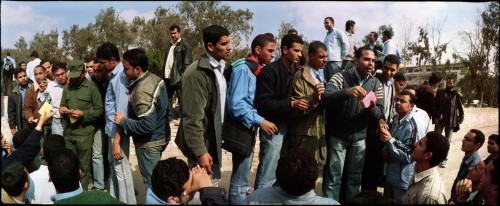
Michael von Graffenried. "Military Recruitment at Al-Azhar University, Cairo," 2007. Color pigment print, 30 X 13 1/2 inches. © Michael von Graffenried, courtesy Parker's Box Gallery, Brooklyn.
Von Graffenried certainly adopts modes of representation that support the possibility that these photographs provide some sort of insight into the authentic pulse of Cairo, that they get “inside Cairo” and to “the heart of the event.” But if the Birqash camel market and a local butcher meet resistance from locals as documents of their own city, yet fit my requirements as signifiers of some authentic vision of Cairene life, then the question is, whose Cairo is this, exactly? Contemplating these images from the other side of the events at Tahrir Square, I can’t help but agree with von Graffenried’s own sentiments concerning the role of the viewer in the determination of meaning. His photographs, it seems, are as much an inquiry into spectatorship as they are into Cairo, which means that they are more about us than they are about anything else.
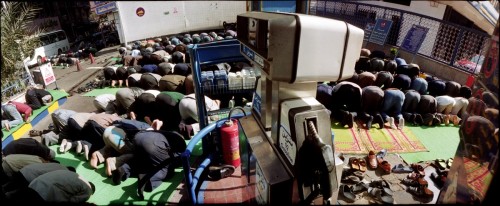
Michael von Graffenried. "Friday Prayers," 2007. Photographic c-print on dibond, 30 x 13 1/2 inches © Michael von Graffenried, courtesy Parker's Box Gallery, Brooklyn.
Inside Cairo: Michael Von Graffenried is on view at Parker’s Box Gallery through July 15th, 2012.



